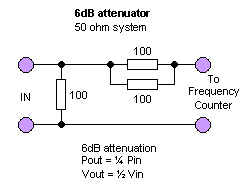 2.5 GHz Frequency counter
2.5 GHz Frequency counter
 Most HF frequency counters need a prescaler in front of the counter unit.
Most HF frequency counters need a prescaler in front of the counter unit. | fq232.pdf | PCB file for 1GHz frequency counter (pdf). |


Frequency (MHz) |
mV rms |
uW (into 50 ohm) |
dBm (into 50 ohm) |
60 |
90 |
160 |
-8.0 |
80 |
60 |
69 |
-11.6 |
100 |
48 |
46 |
-13.3 |
120 |
40 |
32 |
-15.0 |
140 |
33 |
22 |
-16.6 |
160 |
27 |
15 |
-18.2 |
180 |
24 |
12 |
-19.2 |
200 |
24 |
12 |
-19.2 |
220 |
24 |
12 |
-19.2 |
 Attenuator is some resistor to lower the input power and still obtain matching impedance.
Attenuator is some resistor to lower the input power and still obtain matching impedance.
Download windows software fq.zip (1.41Mb) |
|
Click here to go to the software download page! |
|
| led_counter.zip | Software 999MHz with 1kHz resolution (the hex files are zipped!) |
| led_counter_uhf.zip | Software 2.5 GHz with 10kHz resolution(the hex files are zipped!) |
